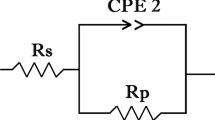Abstract
The polytherms of ice melting in sections of the Ca(NO3)2-Mg(NO3)2-CO(NH2)2-H2O system with different component ratios were studied in the temperature interval from 0 to −40°C. A series of nitrate and nitrate-carbonate reagents that are promising for the creation of anti-acing reagents were found, which form eutectics with ice at temperatures from −25 to −39°C. Their properties, viz., melting properties with respect to ice and corrosiveness on metals and alloys, were determined. An effective corrosion inhibitor was selected.
Similar content being viewed by others
References
Danilov, V.P., Orlova, V.T., Tin’gaev, O.P., Bykov, A.V., and Nikolaev, V.V., RF Patent 2173329, 2000.
Bergman, A.G. and Luzhnaya, N.P., Fizikokhimicheskie osnovy izucheniya solyanykh mestorozhdenii khlorid-sul’fatnogo tipa (Physicochemical Study of Chloride-Sulfate Type Salt Deposits), Moscow: Akad. Nauk SSSR, 1951.
Studeni, J. and Uhrova, D., K bromometrickemu stanoveni nocoviny, Chem. Prumysl, 1962, no. 12, p. 553.
Author information
Authors and Affiliations
Corresponding author
Additional information
Original Russian Text © V.P. Danilov, E.A. Frolova, D.F. Kondakov, L.I. Avdyushkina, V.T. Orlova, 2010, published in Khimicheskaya Tekhnologiya, 2010, Vol. 11, No. 4, pp. 193–197.
Rights and permissions
About this article
Cite this article
Danilov, V.P., Frolova, E.A., Kondakov, D.F. et al. Low-temperature anti-icing reagents in the Ca(NO3)2-Mg(NO3)2-CO(NH2)2-H2O system and their properties. Theor Found Chem Eng 45, 697–701 (2011). https://doi.org/10.1134/S0040579511050058
Received:
Published:
Issue Date:
DOI: https://doi.org/10.1134/S0040579511050058



